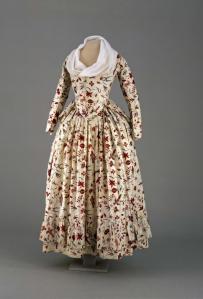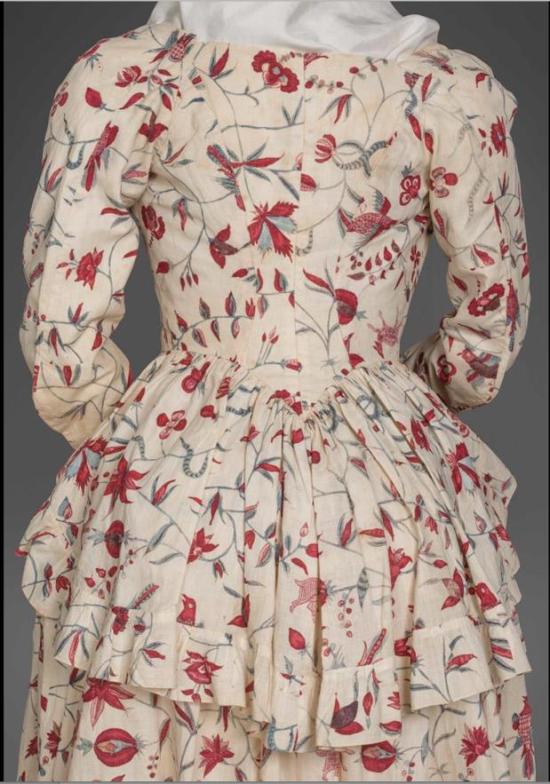Today’s #ColonialCouture post is by Jennifer Van Horn, assistant professor of art history and history at the University of Delaware. She specializes in the fields of early American art and material culture, and she is the author of The Power of Objects in Eighteenth-Century British America.

Figure 1. Woman’s Jacket and Petticoat worn by Ann Van Rensselaer, c. 1790. Albany, NY. Textile: India. Cotton chintz, mordant painted and dyed; tabby linen bodice and sleeve linings. The Colonial Williamsburg Foundation. Gift of Mrs. Cora Ginsburg. Acc. No. 1990-10,1.
Walking down the street in Alexandria, Virginia, in 1786, a white woman spotted a gown that had been stolen from her two years before on the body of an enslaved woman. The gown was a fashionable one: an “Indian Chintz, white Ground, with Stripes and Figures of different Sorts of red, if not other Colours.” It might have resembled the chintz jacket and petticoat worn by Ann Van Rensselaer in New York about 1790 (fig 1), or the more delicately-patterned robe à l’anglaise donned by an unknown American woman around the same time (fig 2). Indian chintz—a light-weight cotton fabric painted or dyed with intricate organic designs and manufactured in India—was popular throughout the Atlantic world for clothing, bed hangings, and upholstery.[1]
The chintz gown’s original owner, Mrs. MacIver, was the wife of an Alexandria ferry owner. She claimed that a white seamstress, to whom she gave “a Night’s Quarters” after hearing “a Tale of feigned Distress,” stole the garment along with two other “elegant, well trimm’d Gowns.” The seamstress sold the Indian chintz to a “Negro of Dr Stewart’s,” who then “sold it to a Negroe Woman belonging to” George Washington. Mrs. MacIver discovered which enslaved woman—Charlotte—when she saw her strolling in Alexandria. Charlotte, then in her early to mid-twenties, was a seamstress for Martha Washington at Mount Vernon.[2]
It is not surprising that Charlotte wore her best clothes to Alexandria. She was likely there on a Sunday, the day the Washingtons did not command her labor. Sundays off the plantation were a time to meet friends and to see and be seen. When she encountered Mrs. MacIver Charlotte was walking with another enslaved woman suggesting the sociability of her trip. Perhaps the women came from the city’s market where Charlotte might have sold vegetables providing her with money for purchases such as the gown. Even on the second-hand clothing market such a gown was a large investment –well beyond the buttons, ribbons, and rum that enslaved consumers more commonly purchased at Virginia stores.[3] Why did Charlotte select this Indian chintz dress? Why was Mrs. MacIver so eager to get it back? As we ponder the importance of fashion in early America what can their actions tell us about fashion’s racialized underpinnings?

Figure 2. Robe à l’Anglaise, 1785-95. America. Textile: India. Cotton, painted mordant, dyed, baleen. Brooklyn Museum Costume Collection at The Metropolitan Museum of Art, Gift of the Brooklyn Museum, 2009; A. Augustus Healy Fund, 1934. 2009.300.647.
Her brightly-colored chintz gown certainly distinguished Charlotte from the majority of enslaved women who wore earth-toned coarse linen shifts, skirts, and short gowns such as those Charlotte helped make for the Washingtons’ slaves. Like many enslaved domestics, Charlotte received finer clothing; the Washingtons paid a tailor to mend her petticoat and jacket in 1774. Yet, her exotic Indian chintz dress was far above such domestic garb. It signaled Charlotte’s conversance with elite trends, gained through the work of her needle as she mended and perhaps helped to make Martha Washington’s clothes. (During the presidential years the first lady sent muslin borders to Mount Vernon for Charlotte to hem). The enslaved seamstress knew intimately which fabrics and forms were popular for elite women’s gowns.[4]
Of course it was the fashionability of Charlotte’s dress that angered Mrs. MacIver. Given the importance of textiles for inculcating racial hierarchy, an enslaved woman wearing such a dress transgressed sartorial boundaries. As historian Robert S. DuPlessis has argued, whites in many slave-holding societies around the Atlantic rim associated enslaved people with the coarse linen planters distributed to them as rations and held cotton to be the province of white settlers. In particular, printed cotton fabrics, like chintz, connoted elite status, as they were commonly worn by merchants and planters, who had easier access to imported goods. For Charles MacIver, who occupied a middling social status as ferry-keeper, clothing was a fundamental means to assert his family’s distance from the enslaved and their commonality with elite planters. No wonder Mrs. MacIver reacted poorly on seeing an enslaved woman with her gown! The MacIvers’ social aspirations were not lost on the well-dressed Charlotte. MacIver recounted how, on being confronted, Charlotte “abused my Wife very grossly… nor would she demean herself so much as to be seen walking with such a Creature as My Wife.”[5]

Figure 3. Rear view Woman’s Jacket worn by Ann Van Rensselaer, c. 1790. Albany, NY. Textile: India. Cotton chintz, mordant painted and dyed; tabby linen bodice and sleeve linings. The Colonial Williamsburg Foundation. Gift of Mrs. Cora Ginsburg. Acc. No. 1990-10,1.
Charlotte’s Indian chintz gown reminds us that fashion, “the collective following of a trend,” refused to fit within the channels set by racial and social hierarchies; the ability to purchase and the knowledge of what was au courante enabled an enslaved woman to rival a white woman sartorially. More than that, Charlotte’s skills allowed her to adapt costume to fit her own sense of style.[6] We do not know exactly what kind of chintz gown Charlotte wore nor what kerchief or jewelry she might have donned with it. But Mrs. MacIver denounced the changes Charlotte had made to the gown: “My Wife says it is altered for the worse, particularly in the Flouncing which went all round the Tail. The Lining originally overshot the Chintz at the Sleeves, which used to be concealed by Cuffs … I understand the Boarder is turned upside down.”[7]
Historic costume provides some idea of Charlotte’s alterations: she re-made the flounce, possibly across the back of the jacket (fig. 3); removed cuffs from the sleeves to reveal the lining; and inverted the border, probably along the skirt’s lower edge. Together these forged a new aesthetic, one displeasing to Mrs. MacIver. In their divergence from Anglo-American taste, Charlotte’s alterations suggest the possible influence of African cultural traditions. As historians Shane White and Graham White have demonstrated African modes of cultural expression often informed enslaved users’ creative adaptations to clothing, for instance dying and patching clothes in bright colors that whites deemed discordant. For Charlotte too, fashion—the transatlantic desire for Indian chintz—offered the beginning point for expressing an aesthetic that modified elite costume to accord with a different sartorial code.[8]
While far from the fashion runways of New York City, the enslaved Charlotte’s stroll down an Alexandria street was also a performance, and a radical one. On Charlotte an Indian chintz dress challenged white authority, undermined racialized dress regimes, and ultimately proclaimed an enslaved woman’s right to her own style.[9] Charlotte’s gown affirmed her personal identity in a society that denied her right to self and asserted that fashion belonged to everyone.
To learn more about Charlotte and the other individuals enslaved at Mount Vernon go to see Lives Bound Together: Slavery at George Washington’s Mount Vernon, on view through September 2020.
[1] Charles MacIver to George Washington, June 17, 1786, The Papers of George Washington Digital Edition Founder’s Online https://founders.archives.gov/documents/Washington/04-02-02-0131(accessed August 1, 2018). For Indian chintz in North America see especially: Amelia Peck, “’India Chints’ and ‘China Taffaty’: East India Company Textiles For the North American Market,” in Amelia Peck, ed., Interwoven Globe: The Worldwide Textile Trade, 1500-1800 (New Haven: Yale University Press for the Metropolitan Museum of Art, 2013), 104-19. For the robe à l’anglaise: Ibid., 290-1. For the short jacket and gown: Linda Baumgarten, What Clothes Reveal: the Language of Clothing in Colonial and Federal America (New Haven: Yale University Press for the Colonial Williamsburg Foundation, 2002), 80-1.
[2] MacIver to Washington, June 17, 1786, Papers of George Washington Digital Edition; Mary Thompson, “Charlotte,” George Washington Digital Encyclopedia George Washington’s Mount Vernon https://www.mountvernon.org/library/digitalhistory/digital-encyclopedia/article/charlotte/ (accessed August 1, 2018). I look forward to the release of Mary Thompson,“The Only Unavoidable Subject of Regret”: George Washington, Slavery, and the Enslaved Community at Mount Vernon (Charlottesville: University of Virginia Press, 2019). For slavery at Mount Vernon see: Lives Bound Together: Slavery at George Washington’s Mount Vernon ed., Susan P. Schoelwer (Mount Vernon, VA: Mount Vernon Ladies’ Association, 2016).
[3] Mary Thompson, “They Appear to Live Comfortable Together,’: Private Lives of the Mount Vernon Slaves,” in Slavery At the Home of George Washington ed. Philip J. Schwarz (Mount Vernon, VA: Mount Vernon Ladies’ Association, 2001), 79-109, esp. 91-2. For enslaved consumers in Virginia see: Ann Smart Martin, Buying Into the World of Goods: Early Consumers in Backcountry Virginia (Baltimore: The Johns Hopkins University Press, 2008), 173-93.
[4] For slave clothing see: Linda Baumgarten, “’Clothes for the People,’: Slave Clothing in Early Virginia,” Journal of Early Southern Decorative Arts 14:2 (November, 1988): 26-70. Thompson, “Charlotte,” George Washington Digital Encyclopedia; Martha Washington, “Letter, to Fanny Bassett Washington, April 19, 1791,” in Martha Washington, Item #454, http://marthawashington.us/items/show/454 (accessed August 13, 2018).
[5] Robert S. DuPlessis, The Material Atlantic: Clothing, Commerce, and Colonization in the Atlantic World, 1650-1800 (Cambridge: Cambridge University Press, 2016), 131, 140, 206, 211-13; MacIver to Washington, June 17, 1786, Papers of George Washington Digital Edition.
[6] Daniel Miller, “Why Clothing is Not Superficial,” Stuff (Cambridge: Polity Press, 2010), 12-41, quotation,15.
[7] MacIver to Washington, June 17, 1786, Papers of George Washington Digital Edition. For chintz borders see: Linda Eaton, Printed Textiles: British and American Cottons and Linens, 1700-1850 (New York: Monacelli Press, 2014), 244-9.
[8] Shane White and Graham White, Stylin’ African American Expressive Culture from Its Beginnings to the Zoot Suit (Ithaca: Cornell University Press, 1998, 5-36, esp. 30-1. My thinking about enslaved people forging a syncretic type of dress has been informed by DuPlessis, Material Atlantic, 152-9.
[9] Seeing Charlotte’s wearing of the gown as an act of resistance also fits well with her assertion of her rights. While the Washingtons were away, Charlotte had an altercation with the farm manager over a piece of meat that culminated in her being whipped. See: Anthony Whiting to George Washington, January 16, 1793. Papers of George Washington Digital Edition. https://founders.archives.gov/?q=Author%3A%22Whitting%2C%20Anthony%22&s=1111311111&r=26 (accessed August 12, 2018); Thompson “Charlotte,” George Washington Digital Encyclopedia. This incident and Charlotte’s punishment is explored more fully in the exhibit Lives Bound Together: Slavery at George Washington’s Mount Vernon.
Wonderful research and a thoughtful conclusion that reinforce the significance of fashion history. You go, Charlotte!
This really helped my research of the era! Thanks!
Pingback: Nursing Clio Sunday Morning Medicine
Pingback: Canadian History Roundup – Week of September 9, 2018 | Unwritten Histories
Pingback: How Enslaved People Helped Shape Fashion History – Guernica